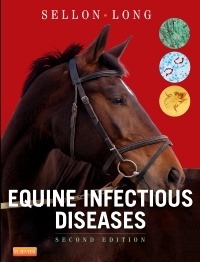Description
Equine Infectious Diseases (2nd Ed.)
Coordinators: Sellon Debra C., Long Maureen
Language: English
Subject for Equine Infectious Diseases:
· 21.5x27.9 cm · Hardback
Description
/li>Contents
/li>Biography
/li>
Section I: Clinical Problems
1. Respiratory Tract Infections
2. Cardiovascular Infections
3. Gastrointestinal and Peritoneal Infections
4. Central Nervous System Infections
5. Infections of Muscle, Joint and Bone
6. Neonatal Septicemia
7. Infections of Skin
8. Reproductive Tract Infections and Abortion
9. Urinary Tract Infections
10. Ocular Infections
11. Systemic Inflammatory Response Syndrome
Section II: Viral Diseases
12. Laboratory Diagnosis of Viral Infections
13. Equine Influenza
14. Equine Herpesviruses
15. Equine Viral Arteritis
16. African Horse Sickness
17. Miscellaneous Viral Respiratory Diseases
18. Viral Diarrhea
19. Rabies
20. Alphavirus Encephalitides
21. Flavivirus Encephalitides
22. Borna Disease
23. Equine Infectious Anemia
24. Vesicular Stomatitis
25. Papillomavirus Infections
26. Miscellaneous Viral Diseases
Section III: Bacterial and Rickettsial Diseases
27. Laboratory Diagnosis of Bacterial Infections
28. Streptococcal infections
29. Staphylococcal Infections
30. Dermatophilosis
31. Rhodococcus Equi Infection
32. Leptospirosis
33. Lyme Borreliosis
34. Lawsonia Intracellularis
35. Salmonellosis
36. Glanders and Farcy
37. Brucellosis
38. Contagious Equine Metritis
39. Anaplasma Phagocytophila Infection
40. Neorickettsia Risticii Infection
41. Enteric Clostridial Infections
42. Systemic Clostridial Infections
43. Botulism
44. Tetanus
45. Miscellaneous Bacterial Infections
Section IV: Fungal Diseases
46. Laboratory Diagnosis of Fungal Diseases
47. Coccidiomycosis
48. Sporotricosis
49. Candidiasis
50. Dermatophytosis
51. Pythiosis and Zygomycosis
52. Aspergillosis
53. Miscellaneous Fungal Infections
Section V: Parasitic Diseases
54. Laboratory Diagnosis of Parasitic Diseases
55. Protozoal Myeloencephalitis
56. Piroplasmosis
57. Nematode Infections
58. Cestode Infections
59. Ectoparasites
60. Miscellaneous Parasitic Infections
Section VI: Prevention and Control of Infectious Diseases
61. Epidemiology of Infectious Diseases
62. Biosecurity and Control of Infectious Disease Outbreaks
63. Infectious Diseases and International Movement of Horses
64. Immunoprophylaxis
65. Antimicrobial Therapy
66. Immunotherapy
Appendices
Infectious Disease Rule-outs for Medical Problems
Laboratory Testing for Infectious Diseases
Manufacturers of Diagnostic Test Kits and Products
Antimicrobial Drug Formulary
Dr. Long has an invaluable background that qualifies her to help Dr. Sellon edit the work of countless expert contributors to this title. Dr. Long has an MS and PhD in veterinary science as well as her DVM in veterinary medicine. Her research interests include several equine and large animal infectious diseases, including Ehrlichia risticii, Neospora caninum, and Toxoplasma. Dr. Long performs much of the background research that makes this book possible.



